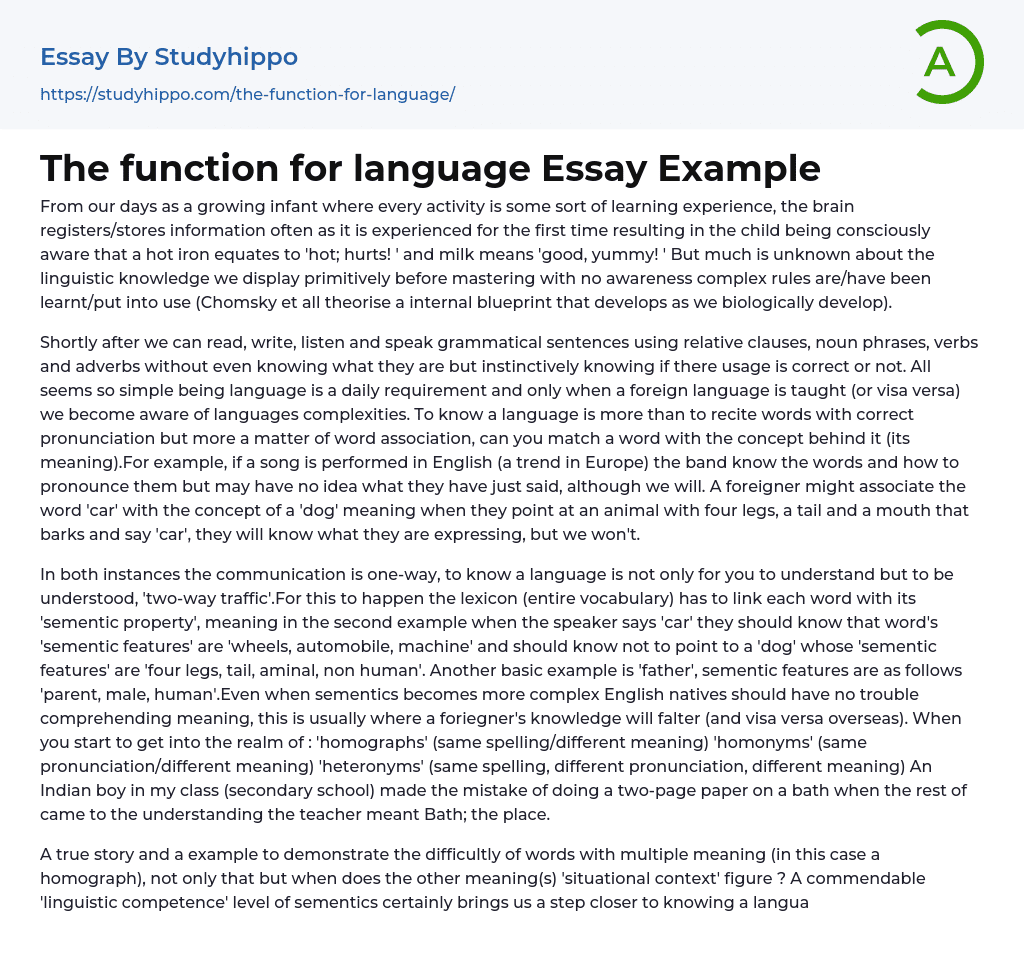As we grow from infants, our brain perceives and memorizes new information through a variety of experiences. Even as a child, we become aware that touching a hot iron causes pain and milk is enjoyable. However, our basic understanding of language and its rules remain unknown until later when we become conscious of these complexities. Theorists such as Chomsky suggest that our internal blueprint for language development develops naturally as we grow biologically.
It is instinctive that we acquire the ability to read, write, speak, and listen to grammatically correct sentences with relative clauses, adverbs, nouns and verbs. Because language is an everyday necessity, its simplicity is often overlooked until learning a foreign language reveals its complexities. Knowing a language involves more than correctly pronouncing words but also includes word association and understanding their meanings.
...For instance, when English songs are sung by foreign bands, they can pronounce the words but might not comprehend their meaning. Conversely, foreigners may associate a word like 'car' with the concept of 'dog,' leading to confusion when they point at an animal with four legs, a tail, and a mouth that barks and say 'car,' a statement that we won't understand.
Understanding a language involves two-way communication, where both parties comprehend and are understood. To achieve this, the lexicon of the language must link each word with its semantic property. For example, when a speaker says "car", they should understand its semantic features like wheels, automobile, and machine. Similarly, the semantic features of words like "father" include parent, male, and human. While English natives can understand even complex semantics easily, non-native speakers may struggle with it.
This is especially true in
cases of homographs (same spelling/different meaning), homonyms (same pronunciation/different meaning), and heteronyms (same spelling/different pronunciation/different meaning). For instance, a student from India once wrote a two-page paper on "bath" when the teacher actually meant "Bath"; the place.
The text provides a real-life example of the challenge posed by homographs and how contextual meaning plays a crucial role in understanding them. It emphasizes the significant role of linguistic competence in semantics to understand language. Despite achieving this competence, most conversations require far more than one-word communication. Syntax, which refers to a speaker's knowledge of sentence structure, is as essential as accurate semantics. Our unconscious understanding of grammar helps us skillfully interpret sentences with multiple meanings and identify the grammatical subject and object relationships in them.
Steve hit Phil in the mouth, causing Phil to have a sore mouth. However, non-native speakers may struggle with differing word orders in phrases and sentences across languages.
When communicating in different languages such as Japanese, German, Dutch, and others, it may be necessary to reword a simple message for accurate translation. In school, I was often baffled by the order of French phrases. An example from An Introduction to Language (Fromkin, Rodman & Hyams) demonstrates that while a speaker of English would ask “how many students does Els teach”, a German speaker would ask “how many students teaches Els”. Unlike animal communication which is limited to stimulus and ritual, human language serves the simple function of communication through speaking, while lions roar and dogs bark.
To illustrate, lions, when agitated, can only express themselves through roaring. In contrast, humans have multiple means to convey their emotions, including words, tone, volume, and
explicit expressions. This highlights the creative aspect of language that enables individuals to choose between vagueness and detail. Bees, for instance, can only communicate by dancing to indicate the presence of food, but they cannot communicate the distance of the food source from the hive like humans can. Our language system is not a preset program with objective meaning as words are often ambiguous and rely on other words with semantic features to achieve precision. This is facilitated by the structure of a sentence since word rearrangement can change the meaning entirely such as in the phrases "this is good!" versus "is this good?".
- Academia essays
- Higher Education essays
- Language Learning essays
- Studying Business essays
- Education System essays
- Study essays
- First Day of School essays
- Scholarship essays
- Pedagogy essays
- Curriculum essays
- Coursework essays
- Studying Abroad essays
- Philosophy of Education essays
- Purpose of Education essays
- Brainstorming essays
- Educational Goals essays
- Importance Of College Education essays
- Brown V Board of Education essays
- The Importance Of Higher Education essays
- Online Education Vs Traditional Education essays
- Academic And Career Goals essays
- Academic Integrity essays
- Brown Vs Board Of Education essays
- Distance learning essays
- Technology in Education essays
- Vocabulary essays
- Writing Experience essays
- Importance of Education essays
- Early Childhood Education essays
- Academic Degree essays
- Academic Dishonesty essays
- School Uniform essays
- Academic writing essays
- Cheating essays
- Bachelor's Degree essays
- MBA essays
- College Life essays
- Grade essays
- Diploma essays
- Phonology essays
- Sentence essays
- Filipino Language essays
- Pragmatics essays
- Millennium Development Goals essays
- History Of Education essays
- Graduate School essays
- Middle School essays
- School essays
- Special Education essays
- University essays




